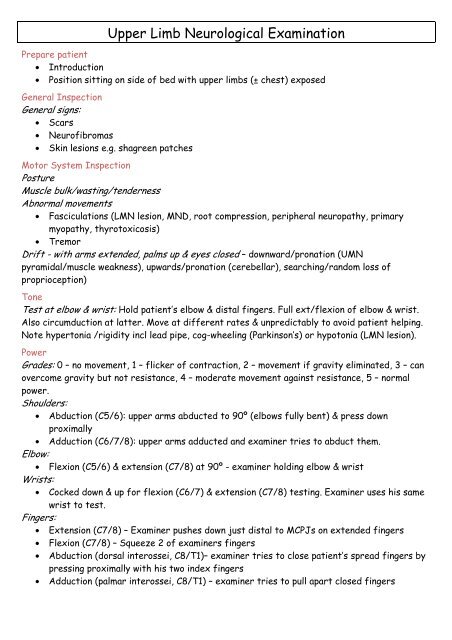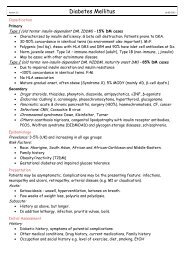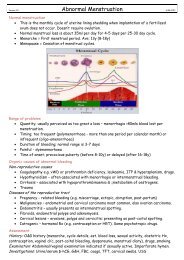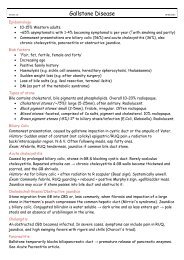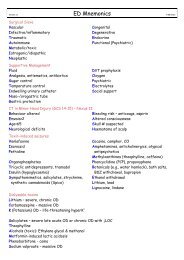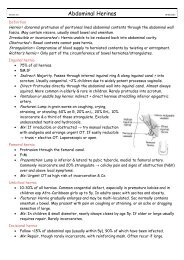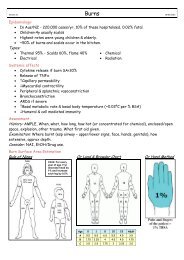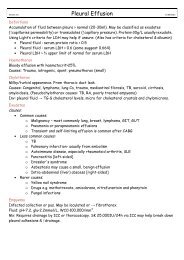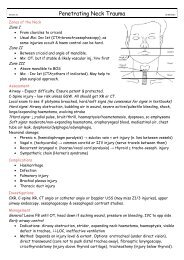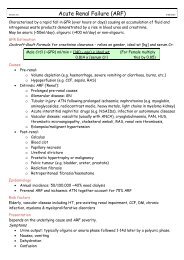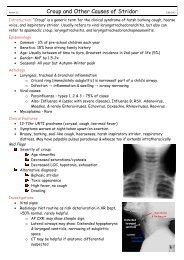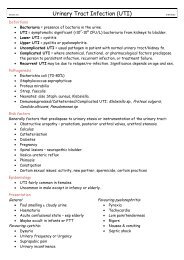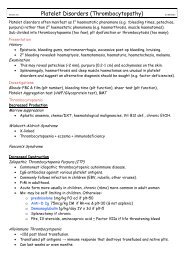Upper Limb Neurological Examination
Upper Limb Neurological Examination
Upper Limb Neurological Examination
Create successful ePaper yourself
Turn your PDF publications into a flip-book with our unique Google optimized e-Paper software.
<strong>Upper</strong> <strong>Limb</strong> <strong>Neurological</strong> <strong>Examination</strong><br />
Prepare patient<br />
• Introduction<br />
• Position sitting on side of bed with upper limbs (± chest) exposed<br />
General Inspection<br />
General signs:<br />
• Scars<br />
• Neurofibromas<br />
• Skin lesions e.g. shagreen patches<br />
Motor System Inspection<br />
Posture<br />
Muscle bulk/wasting/tenderness<br />
Abnormal movements<br />
• Fasciculations (LMN lesion, MND, root compression, peripheral neuropathy, primary<br />
myopathy, thyrotoxicosis)<br />
• Tremor<br />
Drift - with arms extended, palms up & eyes closed – downward/pronation (UMN<br />
pyramidal/muscle weakness), upwards/pronation (cerebellar), searching/random loss of<br />
proprioception)<br />
Tone<br />
Test at elbow & wrist: Hold patient’s elbow & distal fingers. Full ext/flexion of elbow & wrist.<br />
Also circumduction at latter. Move at different rates & unpredictably to avoid patient helping.<br />
Note hypertonia /rigidity incl lead pipe, cog-wheeling (Parkinson’s) or hypotonia (LMN lesion).<br />
Power<br />
Grades: 0 – no movement, 1 – flicker of contraction, 2 – movement if gravity eliminated, 3 – can<br />
overcome gravity but not resistance, 4 – moderate movement against resistance, 5 – normal<br />
power.<br />
Shoulders:<br />
• Abduction (C5/6): upper arms abducted to 90º (elbows fully bent) & press down<br />
proximally<br />
• Adduction (C6/7/8): upper arms adducted and examiner tries to abduct them.<br />
Elbow:<br />
• Flexion (C5/6) & extension (C7/8) at 90º - examiner holding elbow & wrist<br />
Wrists:<br />
• Cocked down & up for flexion (C6/7) & extension (C7/8) testing. Examiner uses his same<br />
wrist to test.<br />
Fingers:<br />
• Extension (C7/8) – Examiner pushes down just distal to MCPJs on extended fingers<br />
• Flexion (C7/8) – Squeeze 2 of examiners fingers<br />
• Abduction (dorsal interossei, C8/T1)– examiner tries to close patient’s spread fingers by<br />
pressing proximally with his two index fingers<br />
• Adduction (palmar interossei, C8/T1) – examiner tries to pull apart closed fingers
• Ulnar nerve – Froment’s sign – Examiner tries to pull card held between patient’s prox<br />
thumb & lateral side of index finger. Weakness of thumb adductor muscle if thumb<br />
flexes<br />
• Median nerve – Thumb abduction<br />
Reflexes<br />
Allow tendon hammer to fall freely. Use teeth clenching for reinforcement if necessary.<br />
Biceps (C5/6) – hit examiner’s finger or thumb<br />
Triceps (C7/8) – support elbow.<br />
Supinator (C5/6) – hit examiner’s fingers<br />
Finger jerks (C8) – place examiner fingertips over patient’s slightly flexed finger tips.<br />
Coordination (all cerebellar tests)<br />
Finger-nose test: slowly, move target finger. Start with finger. Note intention tremor or pastpointing.<br />
Dysdiadochokinesis<br />
Rebound – Ask patient to rapidly lift arms to 90º in front of him. Test ability to reposition<br />
outstretched arms with eyes closed.<br />
Sensation<br />
Note hemisensory, dermatomal, peripheral nerve or glove distribution of any abnormality.<br />
Always test on face or chest first.<br />
Pain (& temperature): With pin (use both blunt & sharp ends) test dermatomes lat upper arm<br />
(C5), thumb (median, C6), posterior 1 st web space (C6, radial), middle finger (median, c7), little<br />
finger (ulnar, C8), proximal medial forearm (T1)<br />
Light touch: Dab (don’t stroke) with cotton wool test same dermatomes. Less discriminating<br />
than pain or vibration.<br />
Vibration & proprioception:<br />
• Test vibration sense with 128Hz tuning fork over DIPJ (test feeling and also when<br />
stopped by examiner). If abnormal continue back through wrist, elbow, shoulder for level.<br />
• Test proprioception at DIPJ, holding sides of finger with patient’s eyes closed after an<br />
open-eyed demonstration. As before test proximally if abnormal.


